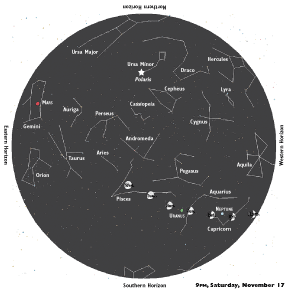Streaking Lights
The Leonids may be small and rather dim, but they move fast
This weekend marks the annual Leonid meteor shower. With the waxing moon setting before midnight, all you need are clear, dark skies and a little luck to spot these shooting stars.
These bursts of light are not stars at all but rather debris shed into space by comet Tempel-Tuttle, which passes through our inner solar system every 33 years. Each November around this time, Earth passes through the mess. The last time Tempel-Tuttle passed near our sun was in 1998, and as Earth moved through the fresh, dense trail of debris in 1999, 2001 and 2002, it rained up to 1,000 meteors an hour.
We’re unlikely to experience any such storms, as the comet and its dense trails have drifted into our outer solar system, pulled away by Jupiter’s gravity. Astronomers are predicting 10 to 20 meteors an hour, with possible bursts of 100 an hour.
The Leonids appear to emanate from their namesake, the constellation Leo, which rises after midnight, and their greatest activity comes a couple hours before dawn Sunday.
While not the largest meteors, the Leonids are the fastest, slamming into Earth’s atmosphere at up to 45 miles per second. As a result, these meteors are dim and fleet, leaving small trails in their wake. For best viewing, you’ll need to escape city lights, and you’ll have to stay alert.
Mars now rises between 8:00 and 8:30pm and is high in the south as daybreak approaches. Saturn rises after midnight. Mercury pays us a visit in pre-dawn skies, rising in the east-southeast an hour before sunrise, around 6:45. Venus shines much higher, having risen an hour earlier. Look for the star Spica between these two planets.
Tidelog®
Illustration: © Copyright 1925 M.C. Escher/Cordon Art-Baarn-Holland; Graphics: © Copyright 2007 Pacific Publishers. Reprinted by permission from the Tidelog graphic almanac. Bound copies of the annual Tidelog for Chesapeake Bay are $14.95 ppd. from Pacific Publishers, Box 480, Bolinas, CA 94924. Phone 415-868-2909. Weather affects tides. This information is believed to be reliable but no guarantee of accuracy is made by Bay Weekly or Pacific Publishers. The actual layout of Tidelog differs from that used in Bay Weekly. Tidelog graphics are repositioned to reflect Bay Weekly’s distribution cycle.Tides are based on National Oceanic and Atmospheric Administration and are positioned to coincide with high and low tides of Tidelog.
